Fruits are nature’s candy, packed with nutrients and flavors that delight our taste buds while keeping us healthy. Among the vast array of fruits available globally, several start with the letter C. Some of these are quite easy to come by and are a global favorite, while some others are exotic and less known.
This list will give you a comprehensive overview of all the fruits starting with C, along with their unique characteristics. We’ll also be looking at the amazing health benefits of each one. So, without further ado, let’s get into it!
1. Cantaloupe
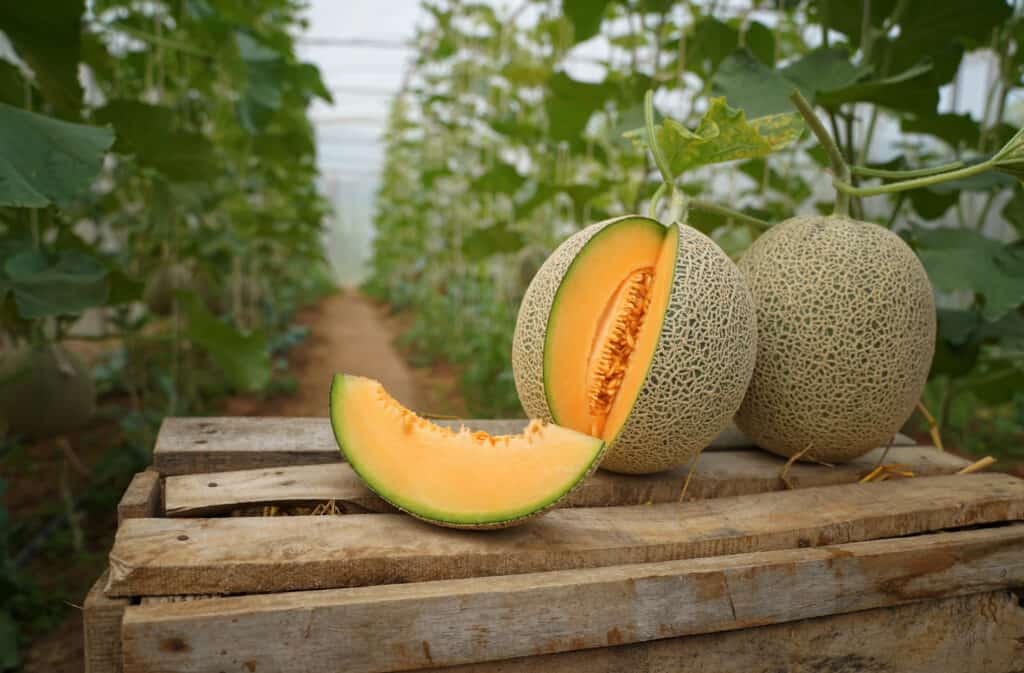
One of the most popular fruits that start with C is, of course, cantaloupe!
©Attasit saentep/Shutterstock.com
Let’s kick off the list of fruits that begin with C with a classic: Cantaloupe. The outer skin of a cantaloupe is firm, showing off a beige-green hue and sometimes even bumpy textures on its surface. The variety found in North America, known as Cucumis melo var. reticulatus, is a kind of muskmelon with a light tan, net-like rind and is cherished for its dense, orange interior.
When a cantaloupe is perfectly ripe, it boasts a sweet, succulent, and soft texture. Cantaloupes are famously known for their signature sweetness and should never leave a sour or bitter aftertaste. If the fruit hasn’t ripened, it can taste bland and have a crunchier texture. On the other hand, if it’s overly ripe, it becomes soft and grainy.
In the annals of history, cantaloupes have been nurtured for centuries, with their beginnings linked to the lands near Egypt‘s Nile River. The story of their origin points to either India or the Middle East.
2. Cherry

Another popular fruit that starts with C is cherry, which can be used in many ways.
©aleksey_rezin/iStock via Getty Images
Cherries usually come in a charming heart shape or are almost round, measuring about an inch across. Their colors span from yellow to red to nearly black.
The majority of experts agree that cherries present a delightful balance of sweetness and tartness, with hints of a woody undertone and a fragrance that brings to mind almonds. In the case of darker cherries, you might even catch a hint of cinnamon and rose flavors.
The roots of cultivated cherries are believed to be traced back to the lands of Western Asia and Eastern Europe. This encompassed an area from the Caspian Sea all the way to the Balkans.
3. Coconut

Coconut is not a nut; it is, in fact, a fruit that starts with C!
©Krzycho/Shutterstock.com
Despite its name, a coconut is, in fact, a fruit, not a nut. In its early stages, coconuts wear a lively green hue, while as they mature, the outer shell turns a rich brown and becomes encircled by dry, brown fibers. Inside, you’ll discover a small quantity of refreshing coconut water and tender, white meat that’s delectable.
The flavor of fresh coconut meat evokes the tropics, delivering a mild nuttiness and a touch of sweetness. Roasting the coconut deepens its taste, infusing it with a more robust woody essence along with a hint of vanilla.
Coconuts are believed to hail from the Central Indo-Pacific region, and they hold great significance as a staple crop in tropical regions.
4. Cranberry
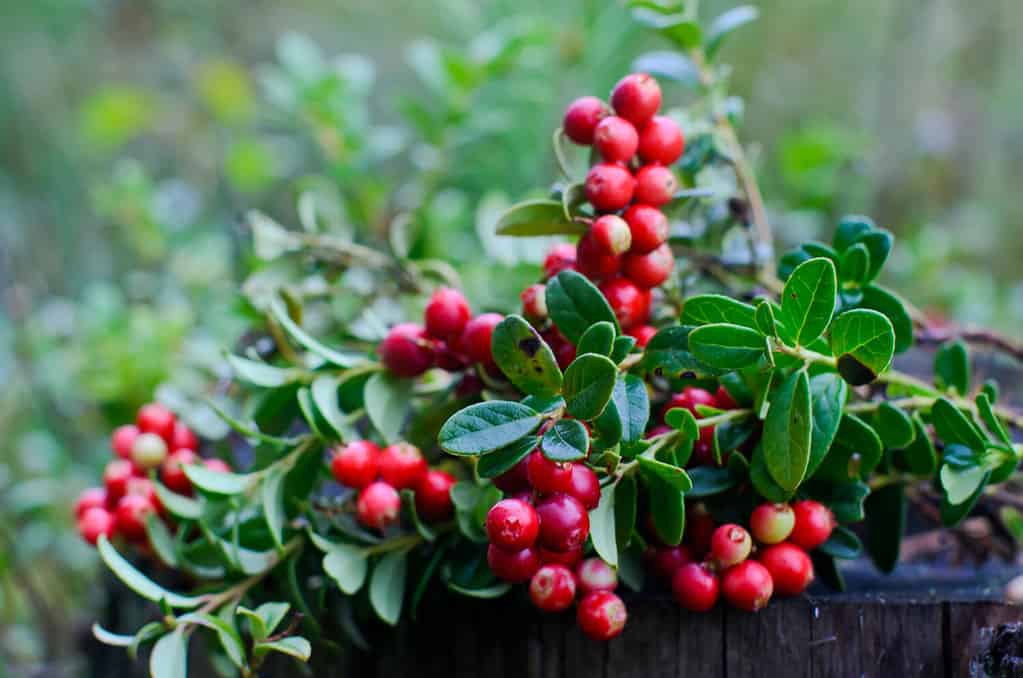
Native to North America, cranberries can be eaten raw or turned into juice!
©Natalia Korshunova/Shutterstock.com
Cranberries come in various shapes: round, elongated, or even pear-shaped. Their colors span from pink to deep red, sometimes with a blend of red and white shades. These vibrant berries flourish on vines in freshwater marshes, primarily in the northern parts of the United States and the southern areas of Canada. Cranberries are kin to wintergreen and blueberries — all part of the same family.
When enjoyed fresh, cranberries burst with a lively, tangy flavor. But when dried or turned into juice, they take on a subtly sweet yet still tangy and invigorating taste.
Notably, cranberries are among the handful of fruits that are indigenous to North America.
5. Cucumber

Yes, that’s right! Cucumbers are actually fruits, not vegetables.
©PixaHub/Shutterstock.com
Although scientifically classified as a fruit, cucumbers find their place mostly in savory dishes like salads or pickles. They usually take on a cylindrical shape, elongated with tapered ends, and can grow up to 24 inches long and 4 inches wide.
Thanks to their high water content, cucumbers offer a gentle, slightly sweet flavor. They’re refreshingly crunchy and cool when eaten raw, which is why we often say “cool as a cucumber.” While the skin brings a more robust taste, many folks opt to keep it on to relish the texture, flavor, and nutritional benefits.
Originating from India, the cucumber stands as one of the oldest fruits in human history.
6. Currant

There are many different types of currants, black currants, white current, and even red currants (pictured).
©Tim UR/Shutterstock.com
Currants come in a variety of colors, from a deep dark purple (black currants) to a vibrant ruby red and even a translucent white. Most often, currants mature into either black or red berries. The red and white variants are tinier than the black ones and look like small clusters of glossy grapes — their skin encases a clear, jelly-like pulp when fully ripe.
Currants present a delightful blend of sweetness and tartness, evoking the essence of berries. Along with this sweet note, there is a brisk acidity and a touch of tannins, which might lead to a subtle puckering sensation in the mouth.
Currants are indigenous to temperate zones worldwide, including North America, Asia, and Europe. In North America, numerous Native American tribes consumed over 75 different varieties of currants native to the continent.
7. Clementine

Clementines have an orange color outside and inside and look very similar to tangerines.
©margouillat photo/Shutterstock.com
The outer skin of a clementine is a rich orange color and has a sleek, shiny texture. A clementine can be divided into about 7 to 14 segments, and much like tangerines, they are usually easy to peel. Generally, they are quite juicy and sweeter, with a lower acid content compared to oranges.
Another notable feature of clementines is that they are seedless. Their exceptional sweetness makes them a preferred choice for many, as they offer a refreshing alternative to the tanginess of other orange variants.
Clementines are cultivated on a hybrid variety of mandarin citrus trees, which are believed to have originated in either China or Algeria.
8. Cashew Apple
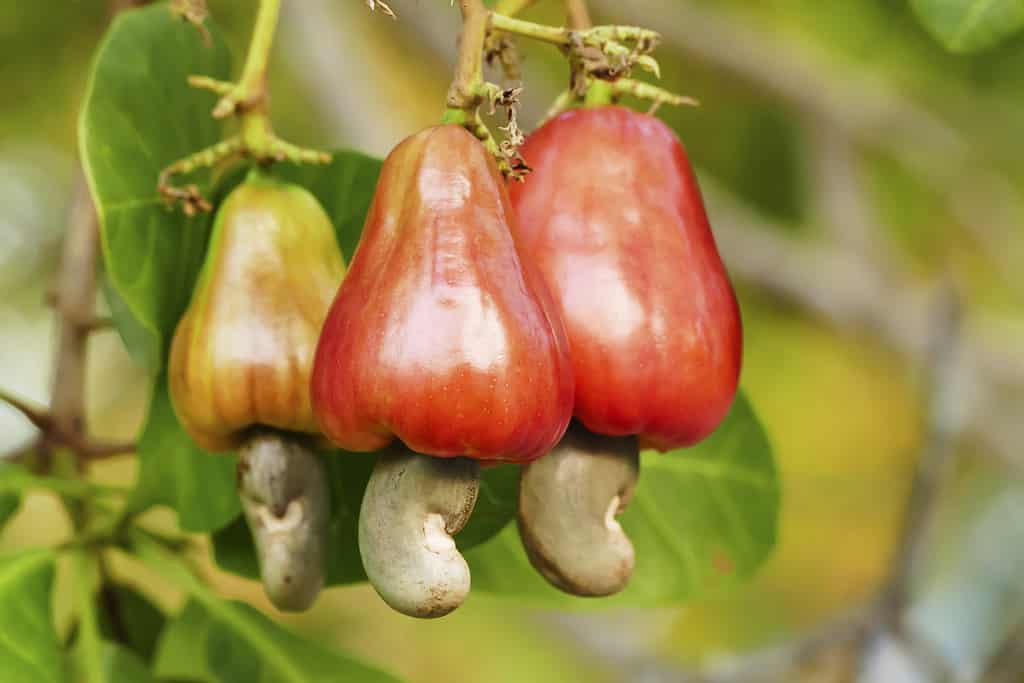
Interestingly, cashew nuts grow on the cashew apple, which can be either red or yellow in color.
©olovedog/iStock via Getty Images
Cashew apple, known as marañón in Central America, matures into a false fruit that is either yellow or red and measures about 2-4¼ inches long. The actual fruit of the cashew tree is a drupe shaped like a kidney or a boxing glove, which grows at the end of the cashew apple.
The taste of cashew apples is uniquely fruity, vegetal, and nutty, making it suitable for lightly cooked dishes. While it is possible to eat these apples directly, the flesh’s tannic quality is often deemed too astringent and not palatable by many.
Originating from the northern and northeastern parts of Brazil, the cashew apple serves as the attachment point for the cashew nut, which is the true fruit of the tree.
9. Cherimoya
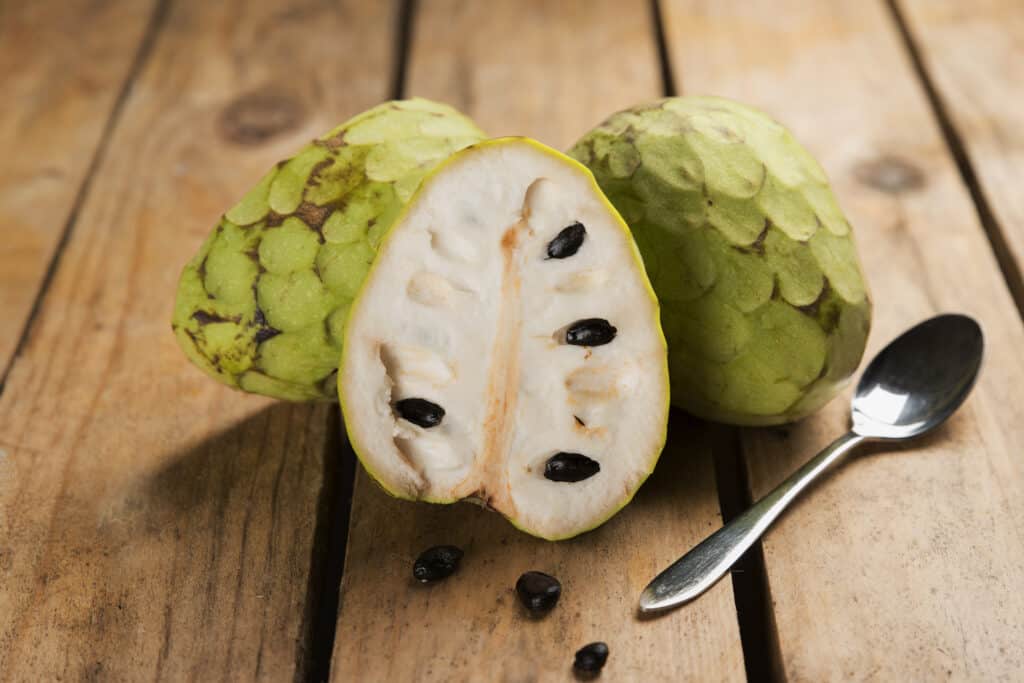
Many consider cherimoya to be one of the most delicious fruits that start with C.
©Fabio Di Natale/Shutterstock.com
Cherimoya fruits are large, round, pale green, and either smooth or with round bumps, containing a white, pulpy flesh. The pulp encases several black seeds, similar in size to beans. To many in the West, cherimoya is an unusual and exotic fruit.
The flavor of cherimoya is a blend of various tropical tastes, including coconut, bananas, strawberries, and mangoes, with some people also detecting notes of pineapple and papaya. The renowned author Mark Twain once proclaimed it as “the most delicious fruit known to man.”
Cherimoyas originally hail from the valleys of Colombia, Ecuador, and Peru.
10. Cempedak

Resembling a stretched melon, cempedak has an orange or yellow juicy flesh.
©focal point/Shutterstock.com
Cempedak looks like a stretched melon, featuring soft spines and a surface marked with tiny hexagons. When unripe, its skin is green and tough, turning yellow or light orange as it matures.
People love cempedak for its edible, juicy flesh, which is usually yellow or orange and high in beta-carotene. Its unique flavor is a delightful combination of durian and mango. Commonly consumed in the regions where it is grown, it can be enjoyed both raw or cooked.
Indigenous to Southeast Asia, cempedak is a significant agricultural product in Malaysia.
11. Cupuacu

Typical to the Amazon region, the cupuacu comes in a brown case, which covers the chocolate and pineapple-flavored pulp.
©diogoppr/iStock via Getty Images
Cupuacu proudly wears the crown of Brazil’s national fruit, and it’s the world’s largest producer of this delight. The fruit boasts an elongated form and a brownish hue, and it is wrapped up in a tough, firm outer layer. Its pulp is a treat, whether savored fresh or turned into delicious juices, jellies, and desserts.
Being a close cousin of the cacao plant, the taste profile of cupuacu is frequently associated with chocolate, yet with a subtle note of pineapple. The white flesh of the cupuacu emits a fragrance that is a blend of chocolate and pineapple, and its juice has flavors that evoke pear, banana, passion fruit, and melon.
This fruit is native to the Amazon region.
12. Custard Apple
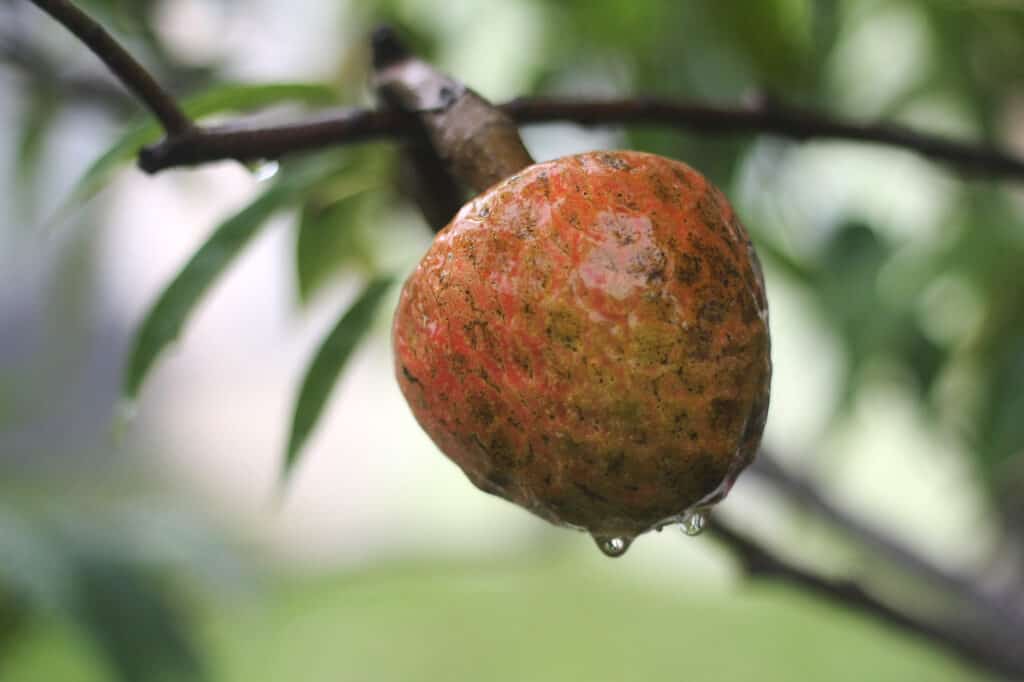
Many people confuse custard apples with another fruit that starts with C: cherimoya.
©jatmika jati/Shutterstock.com
Custard apple, also known as bullock’s heart or sugar apple, has a quilted texture. Its interior is reddish-yellow and extremely soft, which is reflected in its popular name.
Resembling other tropical fruits like pineapple and banana, the custard apple offers a sugary flavor and has a slight vanilla aroma. Despite frequently being confused with cherimoya, many individuals believe cherimoya boasts a superior taste compared to custard apples.
The precise origin of the custard apple is still under discussion, but it is widely accepted that it originated somewhere between southern Central America and tropical South America.
13. Calabash
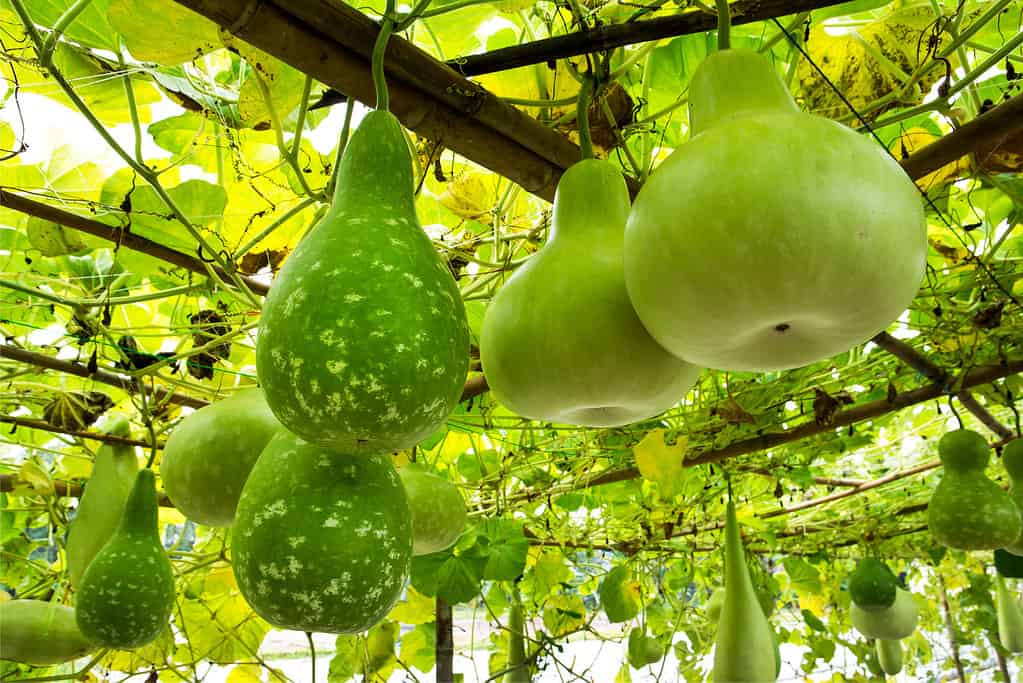
The fruits of the calabash tree tangle from its trunk and branches.
©phanasitti/iStock via Getty Images
The calabash tree showcases its fruits by letting them dangle right from its trunk and branches. These fruits resemble coconuts, and start off as green. But as they mature, they transition into a yellowish or soft brown shade. As they ripen, the inner pulp dries up, leaving behind mostly seeds.
Those who’ve tasted the raw pulp note a gentle bitterness, with subtle whispers of pineapple and guava, though it’s not overly sweet.
Native to Africa and Central and South America, the calabash is celebrated as the national tree of St. Lucia.
14. Calamansi

One of the best citruses that start with C is the calamansi.
©Nokuro/Shutterstock.com
Calamansi is a tiny citrus fruit that boasts an orange color inside and a skin that shifts from green to orange as it grows ripe. It has a somewhat round shape, sometimes slightly flattened, and carries a one-of-a-kind fragrance that blends citrus and floral hints.
Often called “Philippine lime” or “calamondin,” this citrus gem has been a cornerstone in Filipino and Southeast Asian culinary traditions for quite a while. Its flavor brings forth an intensely sour fusion of lemon, lime, and orange.
Its origins can be traced to the Philippines and the neighboring areas of southern China.
15. Camu Camu

A typical Amazonian fruit, camu camu is round in shape and has a tangy and acidic flavor.
©Rafael Nilton Pelizzeri/iStock via Getty Images
Camu camu fruits take on a spherical form, resembling a large grape in size. The skin of the fruit is delicate and glossy, beginning as green and transitioning to a deep burgundy shade as it ripens.
Loaded with citric and ascorbic acid, camu camu berries offer an acidic, tangy, and mildly fruity flavor. However, their tartness can often be too much to handle on its own, prompting the need for sweeteners to balance out the sharpness.
The Camu Camu fruit is considered native to the Amazonian regions of Brazil, Colombia, Peru, and Venezuela.
16. Canistel
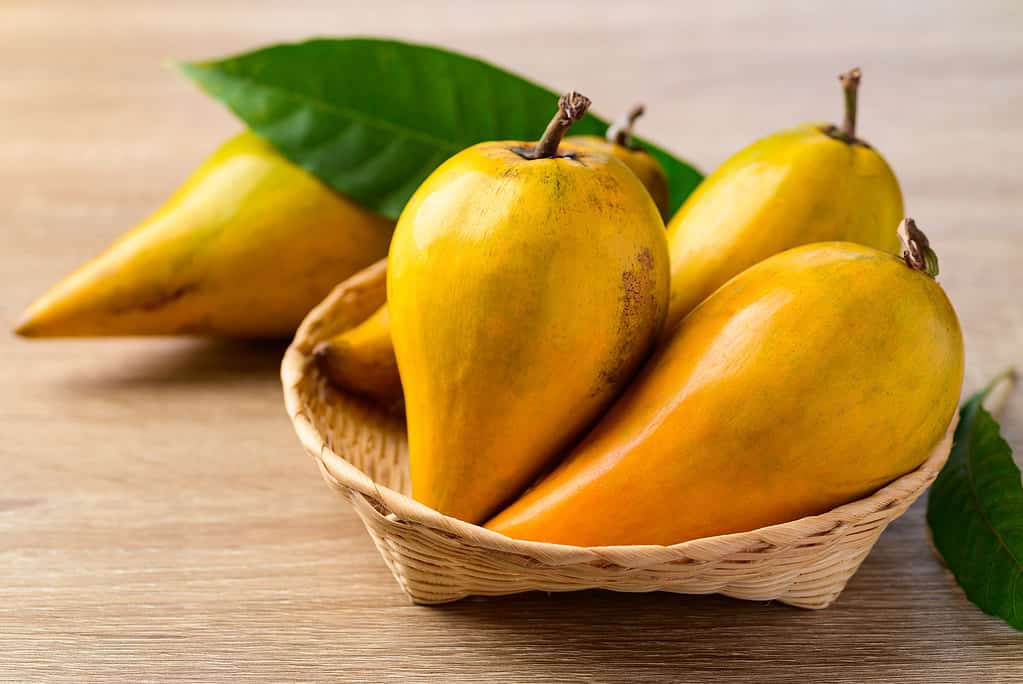
Also called egg fruit, canistel has a creamy flesh that tastes like pumpkin pie or a roasted sweet potato!
©Nungning20/iStock via Getty Images
Canistel is an exotic fruit that almost resembles a mango when cut open. The dark yellow flesh inside is dense, creamy, and smooth, and many liken it to the texture of an egg yolk! For this reason, this fruit is often sometimes also called egg fruit. In terms of flavor, the canistel is most similar to a pumpkin pie or even a roasted sweet potato! Outside, the canistel is orange in color and generally has a pointed end. The fruit is around 3 to 5 inches long and 2 to 3 inches wide. The peel itself starts off thin, waxy, smooth, and green, but when the fruit matures, it turns to a bright yellow or orange.
The origins of the canistel fruit can be traced back to Southern Mexico, Belize, Guatemala, and El Salvador. And since, it has been distributed around to world, namely to the Caribbean, throughout Central America, some parts of Southeast Asia, and even certain regions of Africa!
Comprehensive List of All Fruits that Start with C
- Cantaloupe
- Cherry
- Coconut
- Cranberry
- Cucumber
- Currant
- Clementine
- Cashew Apple
- Cherimoya
- Cempedak
- Cupuacu
- Custard Apple
- Calabash
- Calamansi
- Camu Camu
- Canistel
- Cape Gooseberry
- Cara Cara
- Carambola
- Cacao
- Cactus Fruit
- Carissa
- Caviar Lime
- Cawesh
- Cedar Bay Cherry
- Ceylon Gooseberry
- Charichuelo
- Chayote
- Cherry Plum
- Chico Fruit
- Chocolate-Fruit
- Chokeberry
- Chokecherry
- Citron
- Cloudberry
- Cluster Fig
- Cocky Apple
- Coco De Mer
- Cocoplum
- Coffee Cherry
- Colonnade ‘Maypole’ Apple
- Common Apple Berry
- Conkerberry
- Cornelian Cherry
- Crab Apple
- Crowberry
Summary of Fruits That Start With C
| Number | Fruit | Benefits |
|---|---|---|
| 1 | Cantaloupe | Vitamin C, fiber, and potassium |
| 2 | Cherry | Vitamins A, C, and K, magnesium, potassium, and calcium |
| 3 | Coconut | Vitamins A, C, K, and E, magnesium, and iron |
| 4 | Cranberry | Vitamins E, C, and K1, carbs, and fiber |
| 5 | Cucumber | Vitamins B6, B5, B3, B2, B1, and C, folic acid, calcium, iron, and zinc |
| 6 | Currant | Vitamin C, iron, protein, and potassium |
| 7 | Clementine | Vitamin C, potassium and folate |
| 8 | Cashew Apple | Vitamin C, fiber, magnesium, and potassium |
| 9 | Cherimoya | Vitamins C and B6, folate, and potassium |
| 10 | Cempedak | Vitamins C and B1, potassium, fiber, and magnesium |
| 11 | Cupuacu | Vitamins A, C, B1, B2, and B3, and calcium |
| 12 | Custard Apple | Vitamins A, C, and B6, iron, fiber, copper, magnesium, and potassium |
| 13 | Calabash | Vitamin C, potassium, sodium, iron, and calcium |
| 14 | Calamansi | Vitamins C and A, calcium, and potassium |
| 15 | Camu Camu | Vitamin C, protein, potassium, and calcium |
| 16 | Canistel | Vitamins C and A, calcium, iron, and potassium |
The photo featured at the top of this post is © Nungning20/iStock via Getty Images
Thank you for reading! Have some feedback for us? Contact the AZ Animals editorial team.






